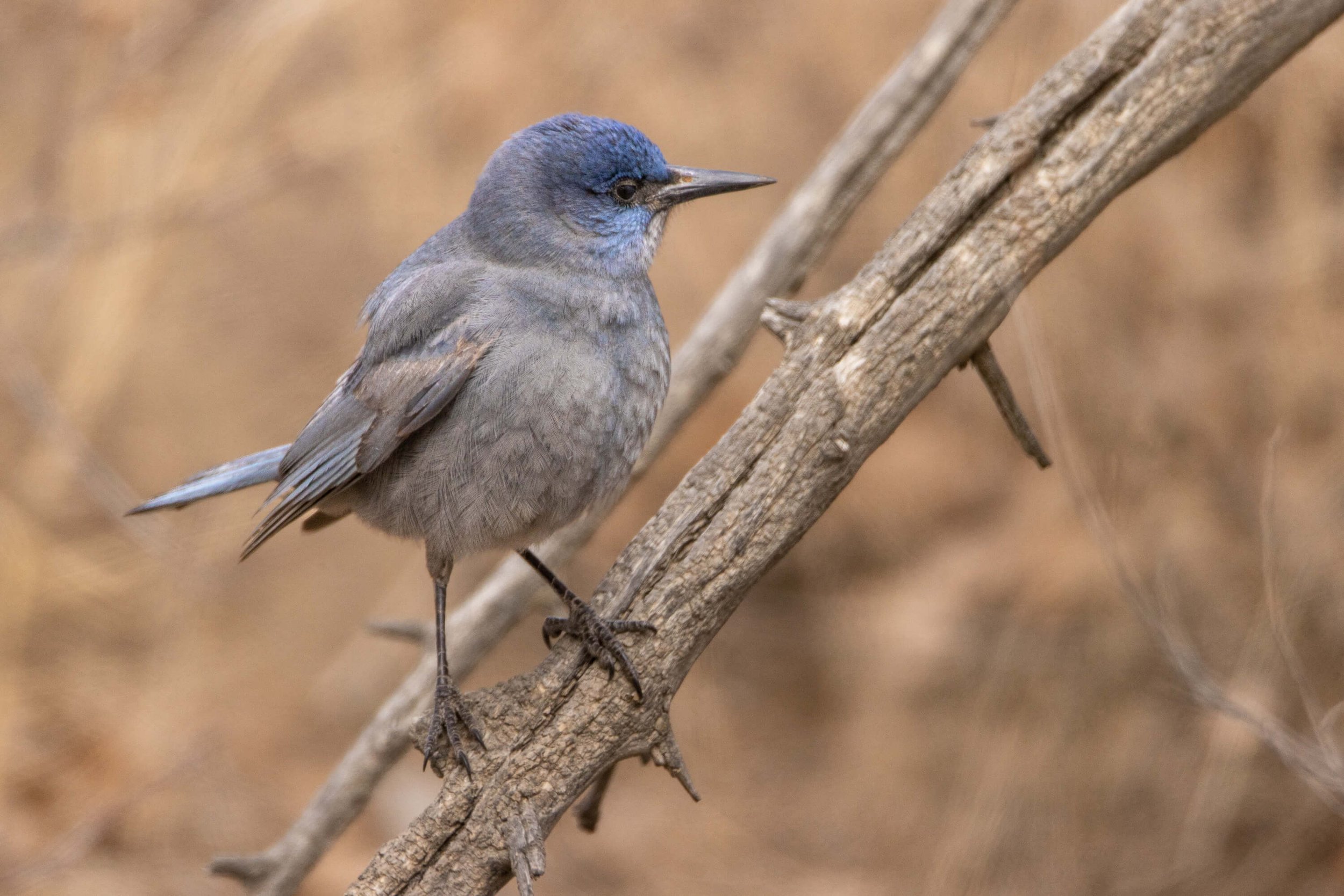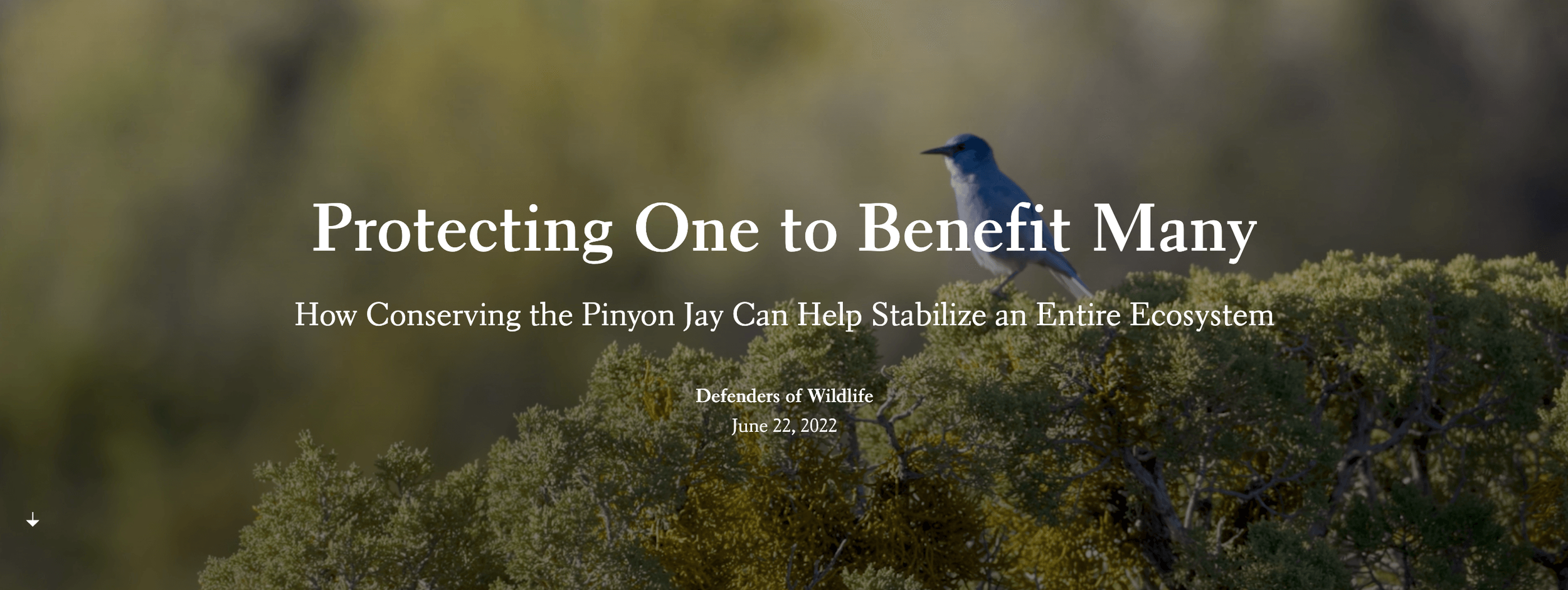Welcome to Piñon Country
A Collaborative Conservation Storytelling Project
The Project
Multimedia
Science
Conservation
Through multimedia storytelling, Piñon Country brings to light the interdependence of life in the Piñon-Juniper Woodland ecosystem. The project highlights the intimate lives of Pinyon Jays as the guardians of this ecosystem, the challenges and threats they face in their habitat, and conservation solutions being implemented across the intermountain west. The project collaborates with and shares the stories of the stewards of Piñon Country: the landowners, managers, conservation groups, citizen scientists, researchers and other individuals working to preserve a functioning landscape.
Multimedia storytelling will inspire the empathy needed to take action to protect and reforest piñon woodlands, invite policy changes in land management and energy development, and support the Pinyon Jay in thriving on this landscape.

The Guardians
Cerulean blue Pinyon Jays gather piñon seeds and store them for winter at cache sites. They are able to remember where they hide 90% of their seeds, but it’s the 10% they forget about that enables the piñon seeds to germinate and these woodlands to flourish. Pinyon Jays have an intimate relationship with piñon pines. They depend on piñon trees for food, shelter, and nesting sites and in turn, they are the main disperser of piñon seeds, allowing these woodlands to rejuvenate and establish in new areas.
Due to drought, land management practices, development, and other causes that are as of yet unclear, piñon-juniper woodlands are changing and Pinyon Jays numbers are in steep decline across the west.
When humans track the health of Pinyon Jay populations we learn a great deal about the health of Piñon Country. These charismatic birds act as an umbrella for several species of concern in the piñon-juniper woodland.
*The birds and woodlands are often written as “Pinyon” in literature, but here in New Mexico we use the Spanish spelling for the trees and woodland: “Piñon”





Piñon Country
THE PLACE
Piñon-juniper woodland covers as much as 15% of the land area in 5 states—Arizona, Colorado, Nevada, New Mexico, and Utah. Although they cover millions of acres, piñon-juniper woodlands are among the least-studied North American forest types.
This woodland provides a wealth of resources and ecosystem services, from wildlife habitat and vegetative cover for watershed protection, to piñon nuts and fuelwood. They are home to millions of urban and rural people and have been a resource and home to indigenous peoples for thousands of years.
More than 70 species of birds are known to breed in piñon-juniper woodland and they support one of the highest proportions of obligate or semi-obligate bird species among forest types in the West. More than in other forest types, animals, or birds, in particular, are critical to the dispersal of the seeds of piñon and juniper trees, the dominant tree species in this ecosystem.
THE THREATS
Mass die-offs of piñon pines from insect infestations brought on by drought and climate change, clearing of land for housing and energy development, and thinning and other land management practices for fire suppression, cattle foraging, and management of grassland species have impacted nesting colonies and foraging sites and changed the available habitat for Pinyon Jays in this ecosystem. The changes in piñon woodlands has resulted in the loss of 85% of the Pinyon Jay population across the West. If the current rate of decline continues, another 50% of their population will disappear in the next 15 years.
Responses by bird communities to environmental changes are well documented, and changes in bird communities often reflect the effects of resource management, conservation, restoration, and environmental degradation.
THE SOLUTIONS
Scientists and a slew of local conservation groups are rallying a small army of citizen scientists to gather the data needed to understand why Pinyon Jays are in decline and figure out how to help them thrive in this landscape.
A conservation framework for Piñon Country is needed to protect and reforest piñon woodlands, invite policy changes in land management and energy development, and help those living in the heart of Piñon Country and the public at large understand the nuances of life in this ecosystem.

The Work
Uniting citizens of Piñon Country to act on behalf of this often overlooked landscape and the sentinel species, Pinyon Jays, will take education, outreach, collaboration, awe-inspiring visuals, and great storytelling. Instead of a wall of green, citizens of Piñon Country will begin to recognize the unique plants, birds, wildlife, and resources of this one-of-a-kind place and become stewards of this essential landscape. Groups across the Southwest will work collectively to amplify one voice for Pinyon Jays and Piñon Country.
My passion is to help the stories and storytellers of Piñon Country be widely known and celebrated.

WHAT YOU CAN DO
VOLUNTEER TO COLLECT DATA ON PINYON JAYS
-

Audubon Southwest - NM & AZ
Training programs for citizen scientists to help collect data on Pinyon Jays in Santa Fe, Albuquerque, Flagstaff with online training coming soon for those in other areas.
-

Grand Canyon Trust - Colorado Plateau
Join their Pinyon Jay citizen science trainings offered a few times a year in Flagstaff or check out their online training program.
-

Great Basin Bird Observatory
Volunteer directly with GBBO to help collect data on Pinyon Jays.
IN THE NEWS
DECEMBER 17, 2022: The Pinyon Puzzle By Christina Selby, Winter Issue, Audubon Magazine. Read the online version here.
APRIL 26, 2022: Protections sought for Western bird linked to piñon forests By SUSAN MONTOYA BRYAN
Read the article in: Associated Press, The Washington Post, U.S. News and World Report, Bozeman Daily Chronicle
JUNE 22, 2022: Protecting One to Benefit the Many: How Conserving the Pinyon Jays Can Help Stabilize and Entire Ecosystem, Storymap by Defenders of Wildlife

The Project Phases
This project will be many years in the making. This is how I plan to create it, one piece at a time.
Phase 1: Species Profiles
Pinyon Jays, as the sentinel species, and other obligate piñon-juniper or species of concern, will have profiles rich with storytelling images that explore their lives and natural history. Profiles will include images, video and other multimedia to create an educational experience ready for publication on various platforms.
Phase 2: Places Profiles
From piñon-juniper woodlands to sagebrush scrublands, the diverse locations where Pinyon Jays live and unique ecosystem of Piñon Country will be explored and celebrated. Profiles will include rich visuals, images, video, illustrations, and other multimedia that highlight the uniqueness and value of this ecosystem.
Phase 3: People Profiles
Once the piñon landscape and its wild inhabitants are well documented, I will move on to highlight the stewards of Piñon Country. These are the public lands managers, Indigenous peoples, local communities and individuals - landowners, scientists, women, academics, resource managers, and youth - who are dedicating their lives to safeguarding biodiversity and who prove every day that people have incredible power to benefit life on Earth.
Phase 4: Deliverables
With imagery and stories in hand, I’ll create a wide range of deliverables including presentation packages with video, image and PDF materials that can be used in public talks, social media, campaigns, agency and stakeholder meetings and presentations, and other events where visuals will make all the difference in conveying the importance of Piñon Country.

The Deliverables
Do you need to get the word out about your work with pinyon jays or the piñon-juniper ecosystem? Consider becoming a partner in Piñon Country and working with me to create materials for your outreach & education campaign, publication, or platform and amplify your efforts through collaboration with other groups.
Species Portfolios
A thorough image portfolio of the Pinyon Jay and/or other species of concern that illustrate their natural history, the issues affecting it, and its habitat. These publication-ready portfolios will assist in getting its story out to a broader audience.
Collaborator Portfolios
During the course of the project, I connect and work alongside a wide range of people and organizations. Call on me to document your work in Piñon Country. I can build multimedia portfolios for use in outreach campaigns or publication.
Publications
I work independently to produce articles in local, regional or national magazines or other outlets where we can share the story of the intimate lives of Pinyon Jays and the need for solutions and conservation efforts that benefit Piñon-Juniper woodland and the obligate bird species.
Social Media Campaigns
With visuals in hands, I’m able to create targeted campaigns for your social media platforms. Launch a campaign exclusively for your organization or in collaboration with other NGOs, research, and government partners of the project to amplify the message.
Interactive Website or Story Maps
Interactive online storytelling features animations, maps, timelines, narrative storytelling and articles, photography and video to immerse viewers in a multimedia experience of the landscape, people, and wildlife in Piñon Country. Work with me to create online experiences and share your message through this immersive medium.
Exhibit
A traveling, educational exhibit "Piñon Country" features 20 images of Pinyon Jay portraits and piñon-juniper landscapes, details, and scientific research. Text panels provide information about natural history, conservation concerns, community science, calls-to-action and more.

Join In
Please contact me at christina [@] christinamselby.com if you are working with Pinyon Jays or in Piñon-Juniper habitat and would like to collaborate.
Project collaborators gain effective visual media assets for outreach, engagement, and funding efforts. I work to document your work and can customize any of the deliverables listed above to support your efforts. I also encourage and provide opportunities for collaboration with all the other champions of Piñon Country.
I AM INTERESTED IN WORKING WITH:
Researchers
Educators
Nature guides/birders
Landowners
Artists/designers/illustrators
Nonprofit organizations
Non-government organizations
Government agencies
Community organizations
Publishers
Image & Video Licensing Gallery Coming Soon

The Storyteller
My passion is to help the stories and storytellers of Piñon Country be widely known and celebrated. I look forward to working with you.
Seven years ago, I stepped into this realm of science writing and photojournalism to be a voice for nature, inspire people, and inform audiences on conservation efforts that need their support. Being immersed in and getting to know nature as a friend is my life’s passion, sharing stories through multimedia is my purpose.
In this niche of nature photography and science writing, getting the image or writing the story is only the first step to bringing it to audiences. My goal is to create beautiful imagery that connects with viewers, leading to love and care and eventually action for the subject. I work to build story platforms that engage audiences beyond a quick scroll.
Through my background as a trained scientist, environmental educator, community organizer, fish tank cleaner, and waitress I have grown skilled in getting a project off the ground, funded, and out into the world.
My work has been published by bioGraphic, National Geographic online, Scientific American, New Mexico Magazine, Outdoor Photographer, among others. I am a trained ecologist with a bachelor’s and master’s degree. My time as a fellow with The Open Notebook and as an intern for Mongabay gave me a great foundation to translate science into engaging stories for understanding by broad audiences.
I am the author of Best Wildflower Hikes of New Mexico (Falcon Guides, March 2020), New Mexico Family Outdoor Adventures (UNM Press, September 2021), and producer and co-director of the feature documentary Saving Beauty: Learning to Live with the Rare Ones Among Us.
My conservation storytelling work has benefitted organizations such as The Nature Conservancy New Mexico, Defenders of Wildlife, New Mexico Wild, NM State Forestry/Endangered Plants Program, and The Native Plant Society.








